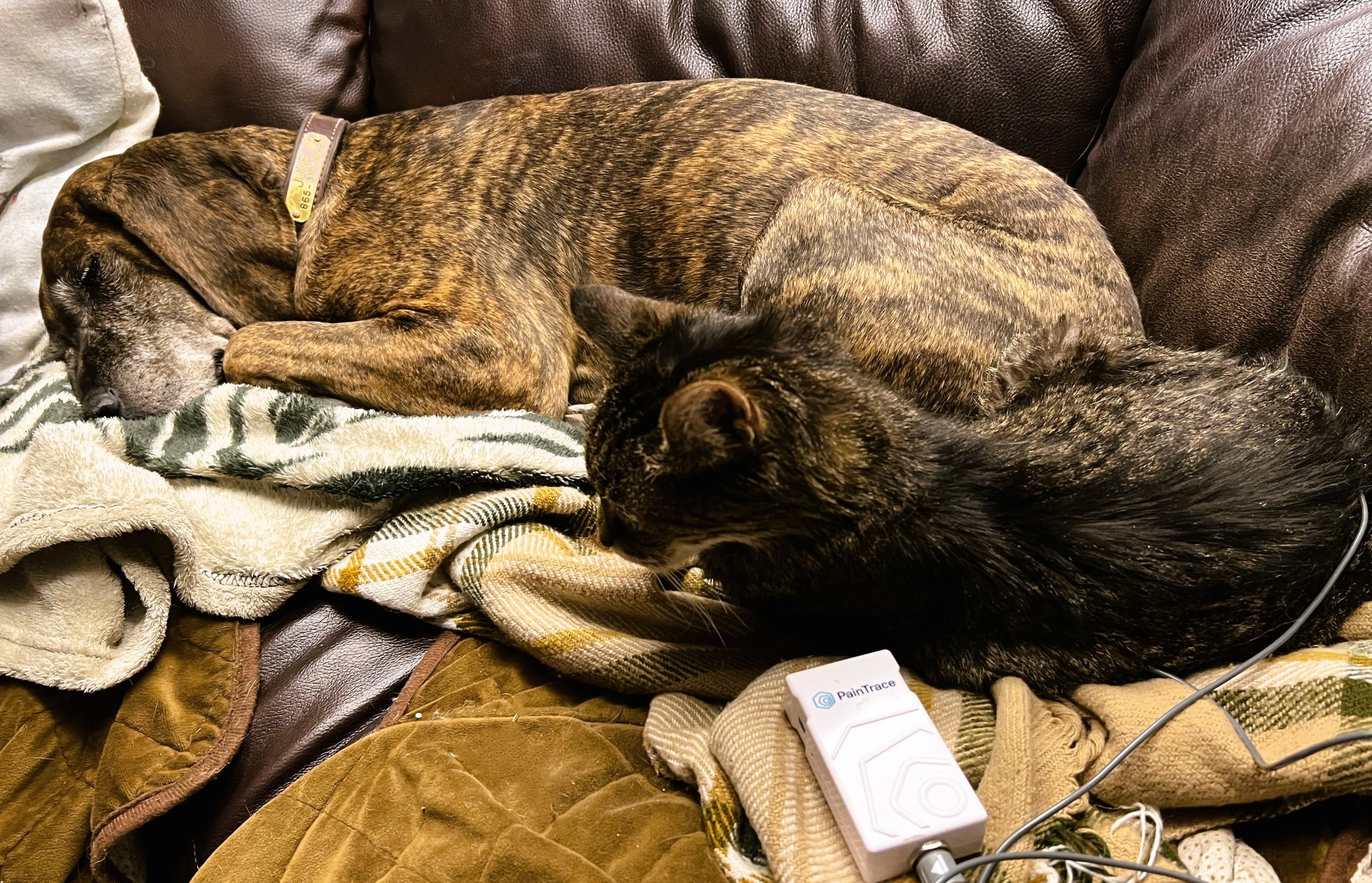New device gives a voice to animals’ pain

How often do you find yourself trying to convince a client that their pet is in pain, even though they aren’t crying? How about those times when you are wondering if your patient’s behavioral changes may be pain-related? The practice of veterinary medicine is undoubtedly more challenging because our patients cannot verbalize what they are feeling.
We are, of course, experts at reading animal body language and gleaning as much information as we can from it. But there are still times when it is hard to know how much pain our patients are experiencing. A new device called PainTrace is changing all that by “giving a voice to pain.”
To learn more, I caught up virtually with three representatives of BioTraceIT, the manufacturer of PainTrace. Deb Dullen, president and CEO; Ralph Harvey, DVM, MS, D ACVAA, chair of the veterinary advisory board; and Katie Hickey, global clinical program director, joined me on a call from the National Institutes of Health (NIH) Pain in Animals Workshop in Bethesda, Maryland, to share more.
What is PainTrace?
As Harvey, a veterinary anesthesiologist, eloquently described it, “the language of pain is electrical activity.” PainTrace is a small device about the size of a deck of cards that is attached by a cable to two small metal sensors created to measure skin-based electrical activity that is indicative of pain within the body.
This noninvasive device boasts the ability to measure both acute and chronic pain, to document trends in pain levels over time, and to help localize pain in the body.
“It takes on the individualized experience of pain,” Dullen said, which includes not only the physical sensation, but also the psychological and social aspects of pain.

How does it work?
PainTrace is designed to be used in the veterinary clinic during a physical exam, while the patient is moving, during a surgical or dental procedure, or during recovery from a procedure. The sensors are placed and acquire a systemic signal comprising the whole body, regardless of the suspected pain localization.
Once the sensors are applied to the skin with an adhesive, the device communicates wirelessly with an iPad equipped with PainTrace software, allowing for real time electrical readings that determine a patient’s “pain score,” which is a cumulative measurement of pain throughout the patient’s body.
On the iPad, users will see a graph with a line tracing of the pain score of the patient and how it changes (if applicable) as the patient moves or when certain parts of the body are touched or manipulated. This helps veterinary professionals to localize the pain and determine its severity.
According to Harvey, PainTrace can detect pain that was otherwise not detectable on physical exam, even by experienced practitioners. Pet owners can also witness the results in real time and have a more tangible indicator of their pet’s pain.
How have the results been validated?
Much of the initial research and development was conducted in humans, who thankfully can verbalize their pain to corroborate the electrical readings. In patients, functional magnetic resonance imaging (fMRI) has been used to measure changes in the brain that are known to be consistent with pain responses. These findings were correlated with pain score readings from PainTrace.
Harvey and Hickey performed a live demonstration for me on the call. Harvey, who has been diagnosed with arthritis in one of his wrists, applied the sensors to his skin. Hickey showed me the pain score tracing on an iPad while she flexed one of Harvey’s wrists and then the other. There was a clear spike in the pain score reading when Harvey’s painful wrist was flexed, but no spike when his other wrist was flexed.
Case summary: A paralyzed dog gets a second chance
Harvey also shared a case summary to illustrate the value of PainTrace. A dog with a spinal injury had become paralyzed. The dog was treated with physical therapy for weeks and did not appear to be improving. The dog owners were strongly considering euthanasia due to poor quality of life.
The treating veterinarian had a PainTrace device and decided to use it to look for any evidence of spinal cord activity. With the device connected, the vet performed a toe pinch and plantar pinch and measured an electrical response. This was enough to convince the owners to hold off on euthanasia and wait a little longer. The dog is now walking, albeit not perfectly.
Future impacts on patient care
Dullen suggests that the implications of more widespread use of PainTrace are significant. “Veterinarians report that when pet owners see pain live, they are more motivated to make a decision with the vet to treat their pet’s pain,” she said, meaning more animals will get the relief they need.
This technology also presents a new diagnostic option for animals who cannot safely be handled without chemical restraint, since PainTrace can still obtain accurate readings in sedated or anesthetized patients.
Future impacts on team wellbeing
The device may also make a positive impact on the mental wellbeing of veterinary personnel. Dullen said that based on published research, one of the biggest contributors to veterinary staff wellbeing is client satisfaction at the time of the visit. When pet owners partner with their veterinary team to provide the care that their pet needs, veterinary personnel can experience greater job satisfaction and improved wellbeing.
Clinical trials are ongoing
The BioTraceIT team has big plans for PainTrace. Clinical trials are ongoing to gain FDA approval for human clinical use. The team also envisions a future where the device is already on hand in pet owners’ homes, for use with both humans and animals. In this scenario, the veterinary team could instruct the pet owner to obtain their pet’s pain score at home to either triage or monitor their pet’s condition.
PainTrace was created to “speak for animals who have no voice,” Harvey said. Hopefully, this technology can also help strengthen our bonds with our patients and our clients.
Further reading
Observational Study Monitoring Pain in 25 Dogs Comparing Novel Non-invasive Device and Veterinary Diagnosis to Differentiate Location and Magnitude of Pain
https://paintrace.com/wp-content/uploads/2021/02/Observational-Study-Monitoring-Pain-in-25-Dogs.pdf
Free CE Webinar on PainTrace
https://biotraceit-7612121.hs-sites.com/dvm360.pt.webinar?__hstc=9881514.eb69ccaf843fb404051bebcb89f938a0.1695763800921.1695938516797.1696040336296.6&__hssc=9881514.3.1696040336296&__hsfp=1319351048
PainTrace Resources
https://paintrace.com/resources/
Photo credit: © Esin Deniz E+ via Getty Images Plus
Emily Singler, VMD, is a 2001 graduate of Penn State University and a 2005 graduate of University of Pennsylvania School of Veterinary Medicine. Her career in veterinary medicine has included experience in shelter medicine, private practice, and as a relief veterinarian. She currently works as a veterinary writer, consultant, and mentor and enjoys writing for both pet owners and veterinary professionals. Her writing interests include public health, preventive medicine, the human-animal bond, and life as a working mom. She is the author of Pregnancy and Postpartum Considerations for the Veterinary Team, which is being published by CRC Press in November 2023 and is available for preorder now at www.emilysinglervmd.com.
Disclaimer: The views expressed, and topics discussed, in any NEWStat column or article are intended to inform, educate, or entertain, and do not represent an official position by the American Animal Hospital Association (AAHA) or its Board of Directors.
NEWStat Advancements & research News Interesting/unusual Columnists Patient care



